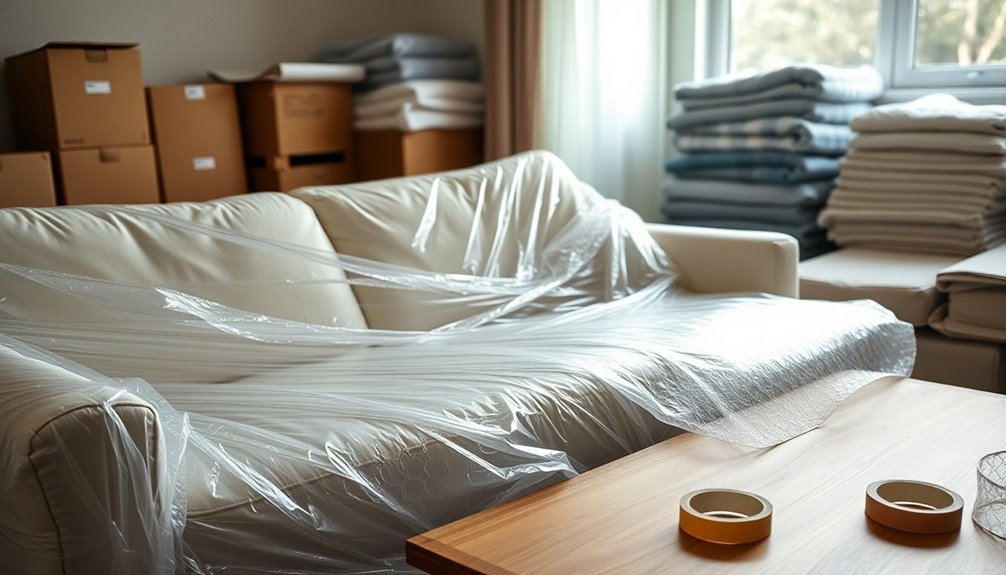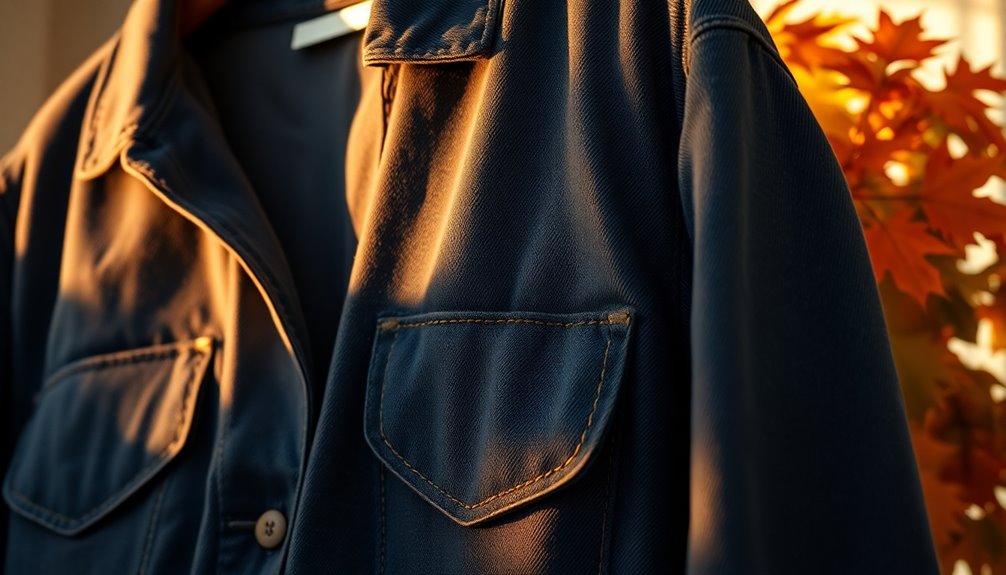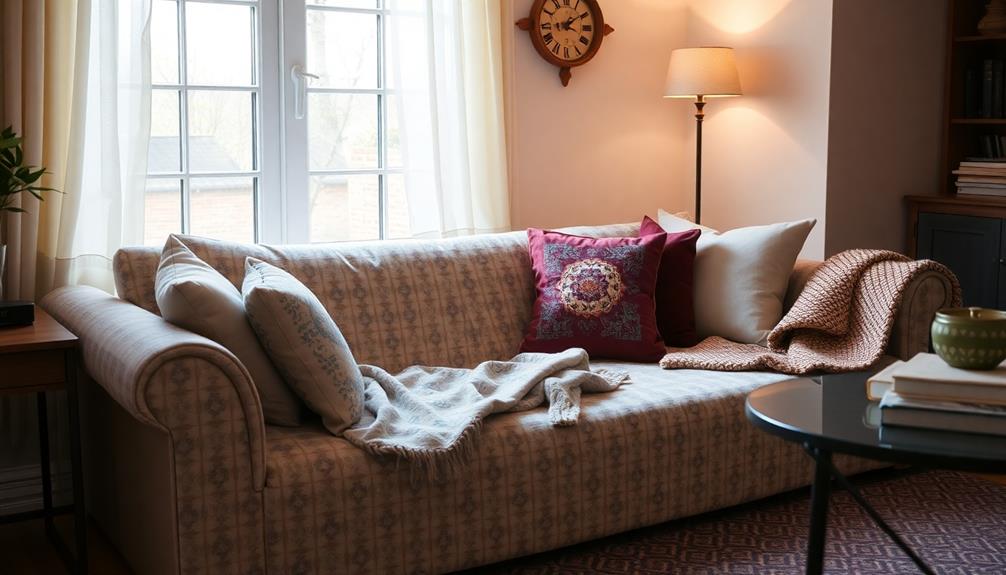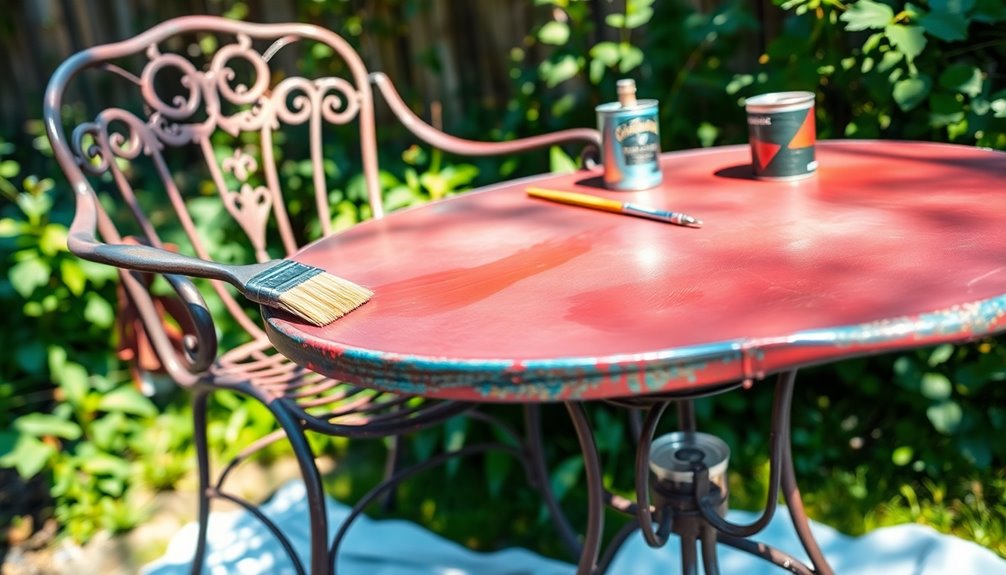To wrap furniture for storage, start by cleaning each piece thoroughly to avoid damage. Disassemble larger items for easier handling. Use moving blankets for protection and bubble wrap for delicate surfaces. Secure everything with high-quality plastic wrap to guard against dust and moisture. Make sure to label each wrapped item clearly for quick identification when you need them back. Keep the storage area organized and elevate furniture to prevent moisture damage. You'll find that these simple steps can make a big difference in protecting your possessions, and there's more helpful information just ahead.
Key Takeaways
- Use moving blankets for heavy items and bubble wrap for delicate pieces to provide adequate cushioning and protection during storage.
- Securely wrap upholstered furniture in high-quality plastic wrap to protect against dust and moisture while allowing for ventilation.
- Disassemble larger furniture to save space and reduce the risk of damage, labeling each part for easy reassembly later.
- Apply shrink wrap loosely to avoid condensation buildup, and secure with packing tape while checking for any gaps.
- Clearly label each wrapped item with descriptive tags and maintain an inventory list for efficient organization and retrieval.
Preparing the Storage Unit
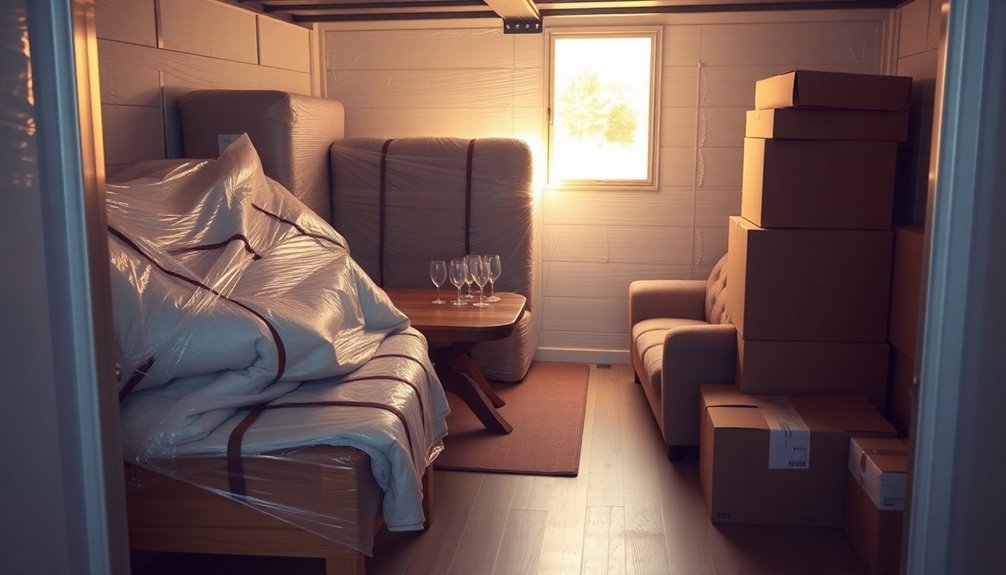
When you're getting ready to store your furniture, start by preparing the storage unit properly to ensure your items stay safe and in good condition. First, lay down plastic sheeting to prevent moisture from seeping up from the floor. You can even use leftover plastic sheeting from wrapping your furniture, making sure it covers the entire floor area. If needed, secure the sheeting with tape to keep it in place.
Consider using a climate-controlled storage unit; it's the best defense against moisture and humidity. Next, ensure proper ventilation by using breathable materials like old sheets or blankets to cover your furniture. Avoid plastic wrap, as it can trap moisture and lead to mold. Make sure your wrapping materials aren't too tight, allowing for air circulation. Additionally, using climate-controlled units is essential for maintaining the quality of your furniture over time.
Finally, disassemble furniture where possible to save space and reduce damage risks. Store the disassembled parts in labeled bags or containers for easy reassembly. By organizing and maximizing space effectively, you'll create a safe environment for your items while keeping them easily accessible.
Cleaning and Inspecting Furniture
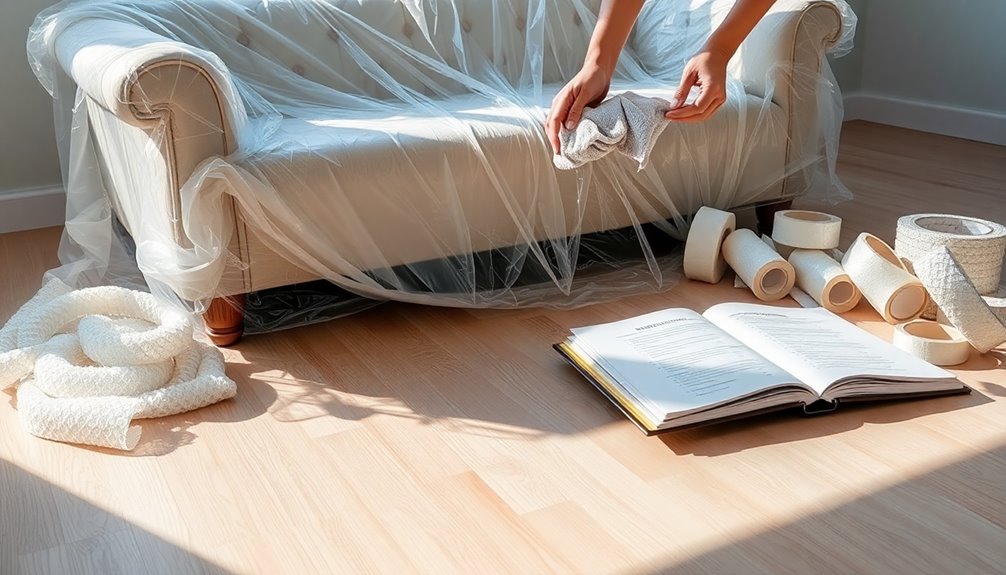
After preparing your storage unit, the next step is to clean and inspect your furniture to ensure it's in top condition before packing it away. Start with wooden furniture by using gentle soap or a wood cleaner to remove dirt. Don't forget to apply a coat of polish to keep the wood from drying out. For upholstered pieces, vacuum thoroughly and treat any stains according to the manufacturer's instructions. If you have metal furniture, clean it with a metal cleaner and a polishing cloth; steel wool can help tackle rust.
For leather items, use a dedicated leather cleaner and finish with a leather conditioner to maintain their texture and appearance. Make sure every piece is completely dry to prevent moisture, mold, and mildew. Place furniture in a well-ventilated area, using fans or dehumidifiers if necessary to speed up drying. Additionally, ensure that all furniture is cleaned thoroughly to prevent damage from moisture during storage.
Finally, inspect each item carefully for any signs of damage or pests. Regularly check on your furniture during storage to catch issues like mold or pests early. Keeping your storage area clean and climate-controlled will help protect your belongings long-term.
Disassembling Furniture
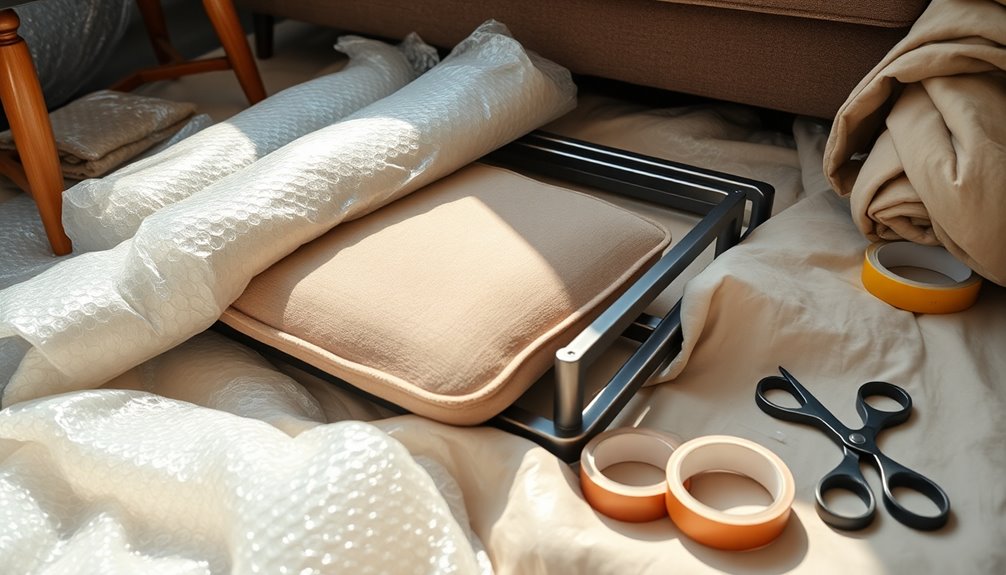
To ensure a smooth move and protect your furniture, disassembling larger pieces is essential. Start by making a list of all items that need disassembly, prioritizing based on size and complexity. Measure your furniture to confirm it fits through doorways and into your new space. Before you begin, gather all necessary tools and find any manuals that came with the furniture for guidance. Essential tools include screwdrivers, wrenches, and a furniture dolly.
As you disassemble, keep track of screws, bolts, and small parts. Use labeled plastic bags or containers to store these components, ensuring everything is organized. Remove drawers and pack them separately to prevent damage. Unscrew hinges to take off doors, and wrap them in blankets or bubble wrap for protection. Don't forget to remove legs from sofas, dressers, and tables to make moving easier.
Be sure to pack disassembled parts together with their respective furniture items and clearly label everything for easy reassembly later. Use moving blankets for larger components like desks and cabinets, and bubble wrap for delicate items. By following these steps, you'll help ensure that all your furniture arrives at your new location in great condition.
Choosing the Right Wrapping Materials
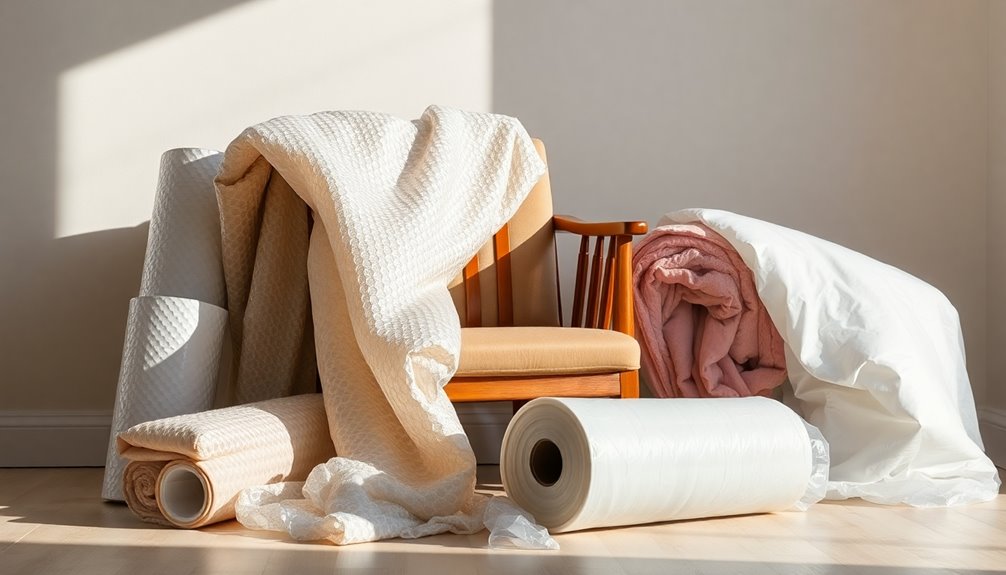
Once you've disassembled your furniture, the next step is to choose the right wrapping materials to ensure everything stays protected during storage or transport. Start with moving blankets; they provide heavy-duty cushioning and are perfect for wooden or metal surfaces, preventing scratches and dents. They're reusable, making them an eco-friendly choice for larger items like sofas and tables. For delicate pieces, bubble wrap is ideal. The air-filled pockets offer excellent protection against impacts, especially for glass tabletops and mirrors. Additionally, using high-quality protection materials can enhance the longevity of your furniture.
If you're wrapping upholstered furniture, high-quality plastic wrap is essential. It protects against dust and moisture while creating a tight seal. Use cardboard as a cost-effective solution, crafting custom-fit sleeves from old boxes to absorb pressure and prevent scuffs. Additionally, consider the specific protection requirements of each furniture material to ensure suitable wrapping techniques are utilized.
Don't overlook furniture pads made from cotton and polyester, which balance protection and cost effectively. Recycled packing paper is another eco-friendly option, cushioning items against dents and scratches. Lastly, consider biodegradable packing peanuts or reusable storage bins made from recycled plastics for added protection against dust and moisture. Choosing the right materials is key to keeping your furniture safe.
Wrapping Techniques
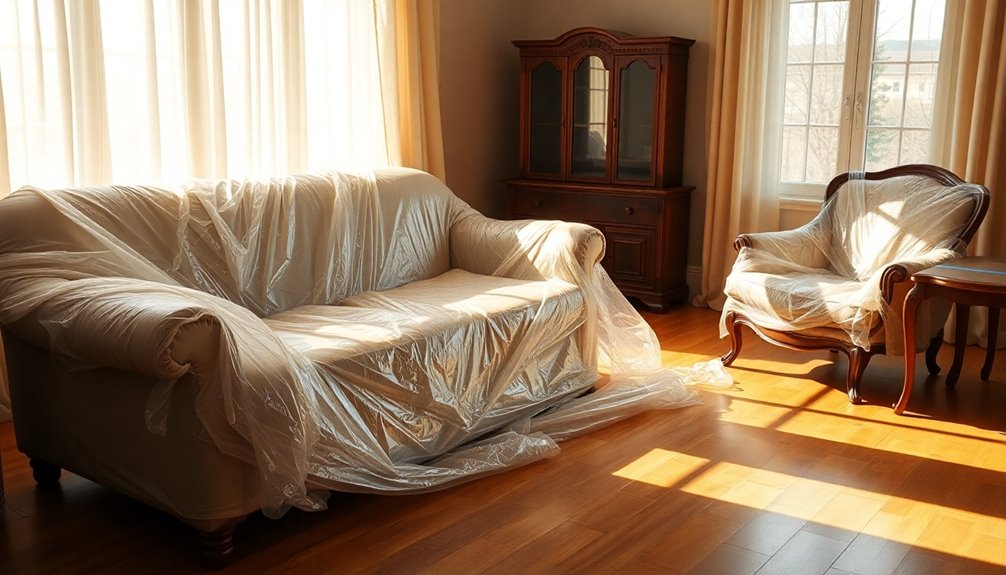
Effective wrapping techniques are crucial for safeguarding your furniture during storage. Start by laying down plastic sheeting in your storage unit to prevent moisture from seeping up from the floor. If possible, opt for climate-controlled storage to minimize humidity. Ensure the unit is clean and dry before placing your furniture inside, and raise items off the floor to avoid direct contact with moisture.
When wrapping upholstered furniture, use spare blankets or sheets to create a barrier against dust and moisture. If you don't have those, consider investing in packing blankets. Drape the materials lightly over the furniture for ventilation, securing them with packing tape if necessary. Protective dust covers can further shield against spills and scratches.
For wooden and other furniture, use shrink wrap or bubble wrap, but avoid wrapping too tightly, as this can cause condensation. Ensure each piece has breathing room. Lightly apply shrink wrap, especially in humid areas, and secure it with packing tape. Professional heat gun is recommended for faster and safer application of shrink wrap. Check for any gaps and cover them properly. Regularly inspect your stored furniture for signs of damage or moisture to maintain its condition.
Stacking and Organization
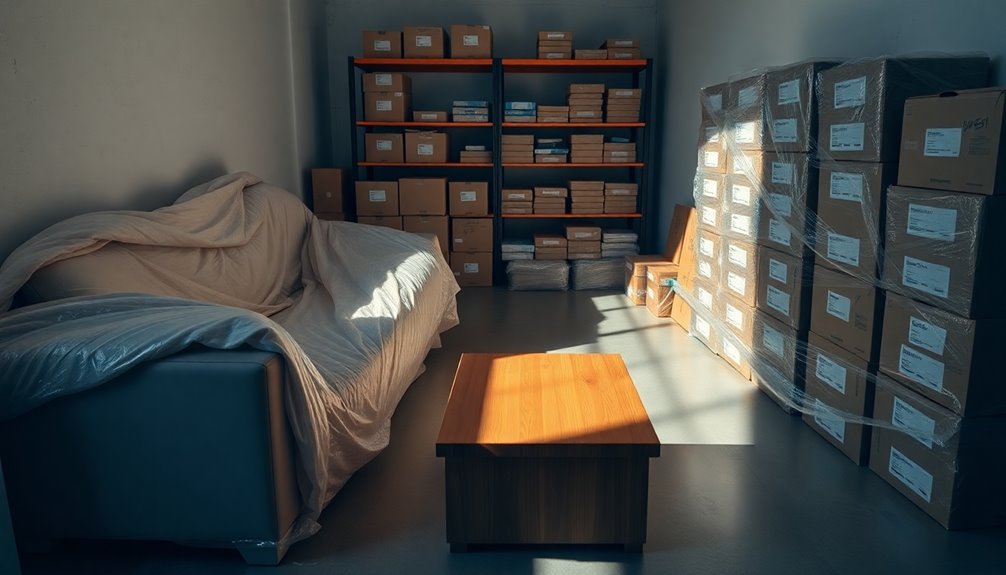
After wrapping your furniture, proper stacking and organization are key to maximizing space and ensuring everything stays in good condition. Start by stacking items evenly to prevent tipping, with heavier pieces at the bottom to protect lighter ones. Leave gaps between items for ventilation and airflow, which helps avoid moisture buildup. If possible, use stackable furniture racks that can be secured to enhance stability and prevent collapse. Remember to limit the height of your stacks to what's safely manageable.
To utilize storage space effectively, consider high-density racking systems that increase storage density or modular solutions that can adapt as your needs change. Opt for compact designs and ensure your storage solutions allow for forklift accessibility when moving furniture. Label each wrapped item clearly and create an inventory list for quick reference. Organize your furniture by categories, like room or furniture type, making retrieval easier. Keep frequently used items accessible and develop a systematic approach to storage to save time when you need to retrieve them. Finally, don't forget to periodically check on your stored furniture to maintain wrapping materials and prevent any long-term damage.
Protecting Delicate Items
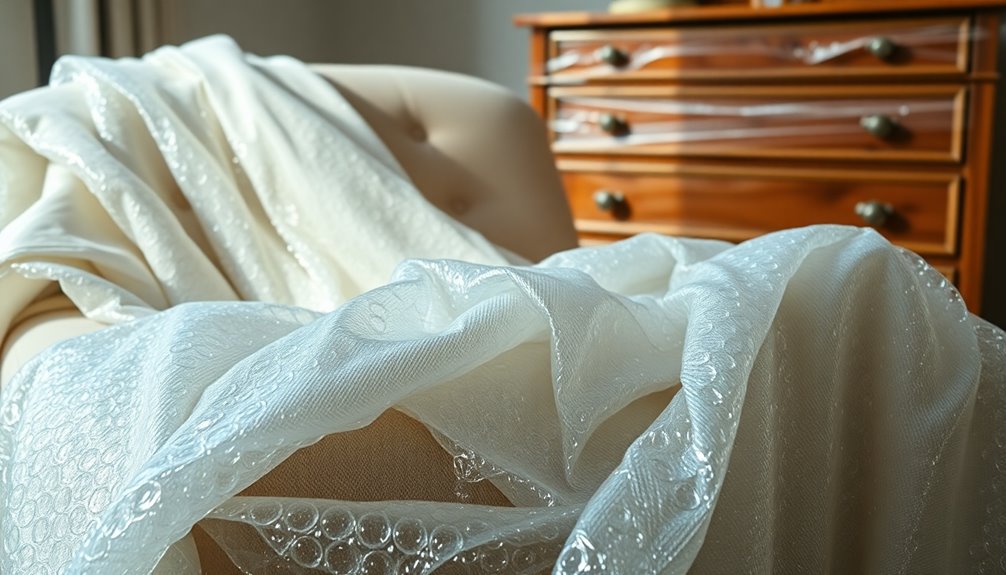
When it comes to protecting delicate items during storage, using the right materials and techniques is essential for preventing damage. Start by choosing materials like plastic wrap for smooth surfaces, ensuring a tight seal on tables and cabinets. For fragile pieces, bubble wrap is your best friend; wrap glass tabletops, mirrors, and electronics carefully to shield them from breakage and scratches.
Before wrapping, clean the surfaces to remove dust and dirt, and inspect for any existing damage or loose parts. If possible, disassemble larger furniture to minimize risk. When wrapping, make sure to cover every inch tightly and secure with packing tape to avoid any unraveling. Additionally, make sure to store items in a cool, dry location to avoid extreme temperature effects.
For intricate or irregularly shaped items, opt for packing paper or butcher paper. If you're storing high-value items, consider using foam sheets for extra protection. Remember to cushion sensitive components, like handles and spouts, with additional layers of wrapping material.
Lastly, keep delicate items off the floor by using pallets or shelves to protect against moisture and pests. Following these steps ensures your delicate items remain safe and intact during storage, giving you peace of mind.
Labeling and Inventorying
Properly labeling and inventorying your furniture before storage is crucial for ensuring you can easily locate items later. Start by using clear and descriptive labels on each wrapped item. Make sure these labels are easy to read and contrast well with the wrapping material. Consistency is key, so place the labels in the same location on each item. If any piece has specific orientation needs, include arrows to indicate the correct positioning. Additionally, consider incorporating unique labels for each location to prevent confusion when storing items.
Next, create an inventory list. Assign a unique number to each wrapped item or box and specify where each item should go in your new space. Don't forget to document the condition of items for future reference or potential insurance claims. Organize your inventory by categories, like item type or room assignment, and consider using a color-coded system for quick identification.
Lastly, maintain a master inventory list, including essential details like product name, description, and quantity. Drawing a diagram of your storage area can help visualize where everything is placed. Remember to update this inventory as items are added or removed to keep everything accurate and easily accessible.
Tips for Long-Term Storage
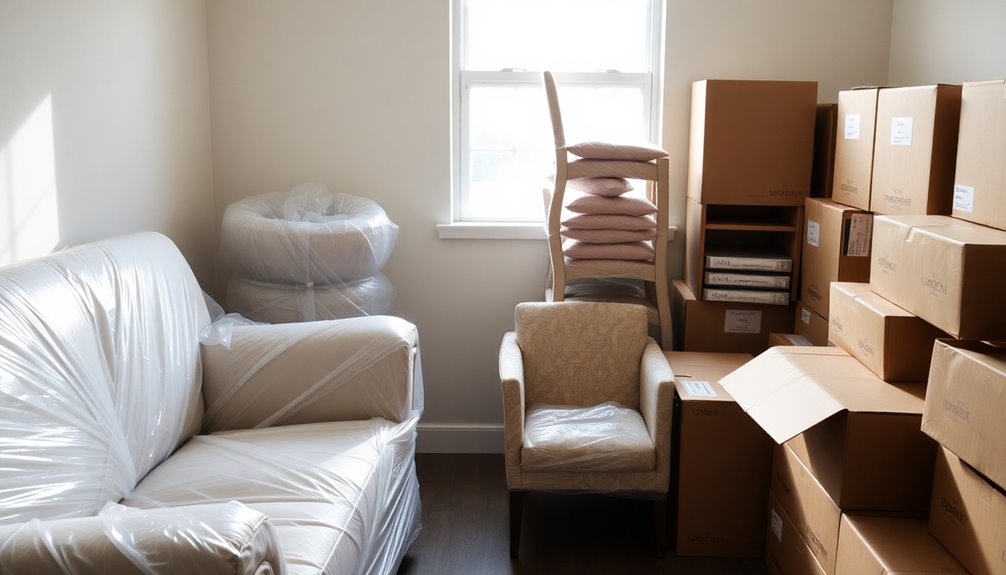
To ensure your furniture remains in great condition during long-term storage, it's essential to take proactive steps in preparation. Start by choosing a climate-controlled storage unit to protect your items from extreme temperatures and humidity. Lay down plastic sheeting on the floor to prevent moisture damage and elevate your furniture using pallets or boards to reduce moisture absorption. Make sure to leave space between your furniture and the walls for proper air circulation. Additionally, selecting clean, secure, and climate-controlled units is crucial for safeguarding your belongings.
Before you wrap your items, clean them thoroughly to avoid odors and mold growth. Use breathable materials like blankets or sheets to cover your furniture, allowing it to breathe and preventing mold build-up. For wooden pieces, apply a protective layer of wax or polish before wrapping them lightly with bubble wrap or furniture blankets. Avoid tight wrapping, especially with plastic, to prevent condensation.
When storing, disassemble larger pieces when possible and label the parts for easy reassembly. Organize your items efficiently, placing heavier pieces at the bottom and lighter ones on top. Remember to leave space between items for ventilation, ensuring your furniture stays protected throughout its time in storage.
Final Checks Before Storage
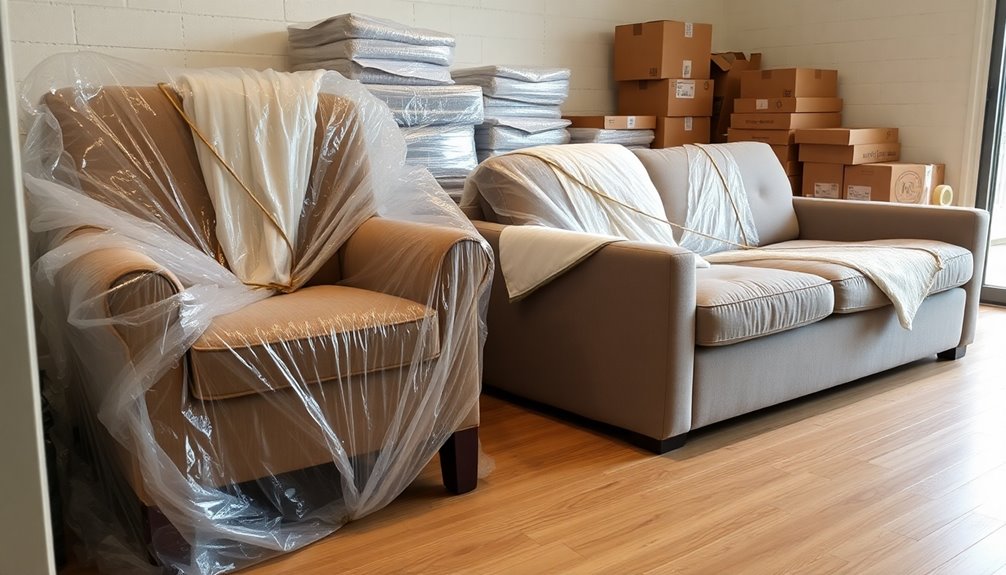
Ensuring you've completed final checks before storing your furniture can make a significant difference in maintaining its condition. First, clean all pieces thoroughly to remove dust, dirt, and grime. Use appropriate products, like wood polish for wooden items and fabric cleaner for upholstery. Don't forget to treat leather furniture with a quality leather care guard. Ensure fabric furniture is completely dry to prevent moisture and mold.
Next, disassemble larger items like tables and bed frames to save space and minimize damage. Remove legs and store important nuts and screws in labeled bags attached to the furniture. Use breathable covers, blankets, or drop cloths for protection, avoiding plastic since it can trap moisture. This way, you can ensure your furniture is well-preserved during the storage process. Additionally, when reassembling your furniture in the storage space, consider utilizing furniture arrangement tips for living room to optimize the available area and enhance accessibility. Stack lighter items on top of heavier ones and position frequently used pieces near the front for convenience. Taking the time to carefully plan your storage layout will not only protect your furniture but also make it easier to retrieve items when needed.
Label everything clearly with a consistent system, such as color-coding or numbering. Create an inventory list noting each item's condition and location in the storage unit. Group similar pieces together and leave space between items for easy access.
Finally, prepare your storage unit by laying down plastic sheeting and elevating furniture on pallets or cinder blocks. This will safeguard against moisture and ensure your furniture stays in top shape until you're ready to use it again.
Frequently Asked Questions
How Long Can Furniture Be Stored Without Damage?
You can store furniture without damage for varying lengths, depending on how well you prepare it. For short-term storage, up to three months, minimal protection works. Medium-term, up to a year, requires more thorough care, including disassembly and climate control. For long-term storage, over a year, meticulous cleaning and protective measures are crucial. Regular checks ensure your furniture remains in good shape, regardless of how long it's stored.
Is It Safe to Store Furniture in a Garage?
Storing furniture in a garage can be risky. Temperature swings and humidity can damage wood and fabric, while pests might invade. You should monitor humidity levels and use breathable covers to protect against infestations. Security's also a concern, so make sure to secure the garage. Elevating your furniture can prevent moisture exposure and damage. Regularly cleaning and organizing the space is vital to maintain a safe environment for your stored items.
Can I Store Furniture Outside Temporarily?
You can store furniture outside temporarily, but be mindful of the materials. HDPE and aluminum furniture can withstand the elements, while wood should be kept uncovered to avoid moisture issues. Always bring in upholstery and cushions to protect them from harsh weather. If you're using storage bins, ensure they're waterproof. For maximum protection, consider using storage benches or bags to keep your items secure and reduce maintenance while they're outdoors.
What Items Should Not Be Stored With Furniture?
You shouldn't store certain items with furniture to avoid damage. Keep delicate fabrics, electronics, and important documents separate, as humidity and temperature changes can ruin them. Avoid food, clothing, and mattresses, which can attract pests. Additionally, hazardous materials like paint or flammable items must never be stored with your furniture. Lastly, living things, including plants and animals, need proper care and shouldn't be placed in storage units with your belongings.
How Do I Prevent Pests in My Storage Unit?
To prevent pests in your storage unit, start by keeping food and scented items out. Clean your belongings thoroughly to remove any food residue. Avoid eating inside the unit and choose a facility that prohibits food storage. Use plastic containers instead of cardboard to block pests, and elevate items off the ground. Regularly inspect your unit for signs of infestations and maintain cleanliness to create an unwelcoming environment for unwanted pests.
Conclusion
Wrapping your furniture for storage doesn't have to be overwhelming. By following these steps, you can ensure your pieces stay safe and in great condition. Remember to clean, disassemble, and choose the right materials, while also protecting delicate items. Don't forget to label everything for easy access later. With a little preparation and care, your furniture will be ready for long-term storage, making your transition smooth and stress-free. You've got this!
